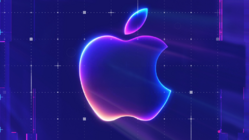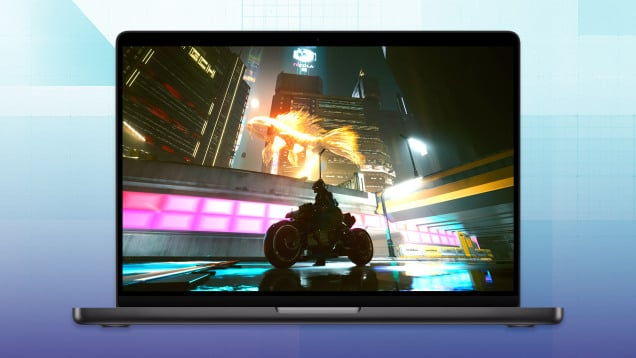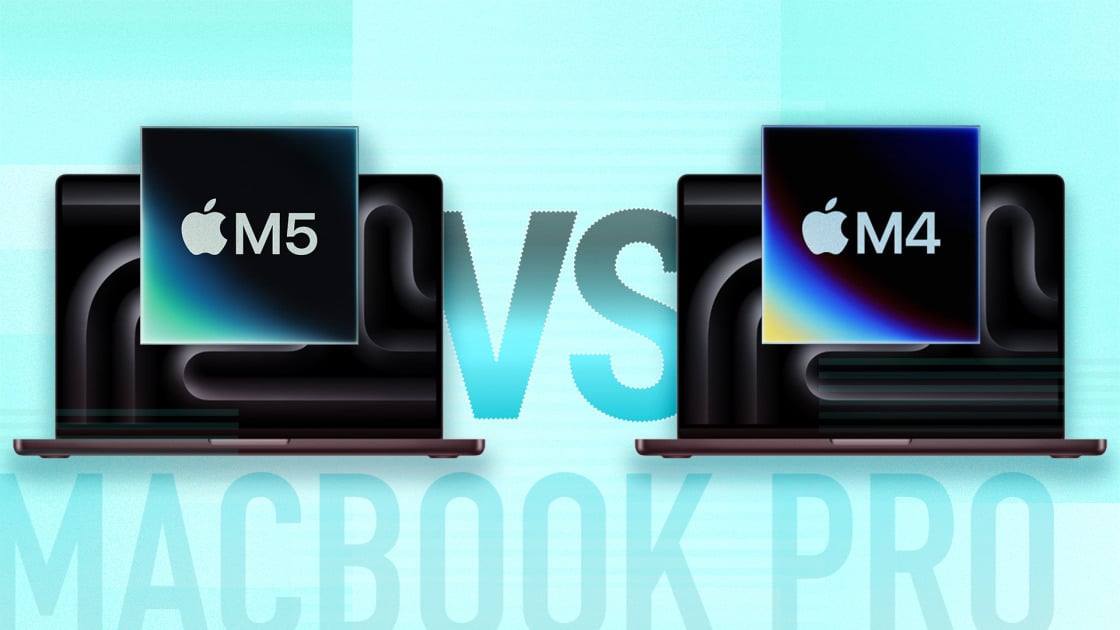MacBook Pro Design: Déjà Vu (Same Features, Too)
Despite the 2025 refresh, the new Apple MacBook Pro 14 is a dead ringer for the last one. The overall design is the same, with an identical aluminum chassis, and so is everything else. In fact, it’ll be easier to list everything that hasn’t changed and take care of it in one go.
The chassis is identical, with the aluminum construction in the same Silver and Space Black colors. Both models measure 0.61 by 12.3 by 8.7 inches (HWD) and weigh 3.4 pounds. Set them side by side, and you’ll be stumped which is which.
The MacBook Pro has the same 14.2-inch Liquid Retina XDR display in 2025 that it had in 2024, though that’s no bad thing. The screen has a 3,024-by-1,964-pixel resolution at 254 pixels per inch, backed by a mini LED backlight. I praised the 2024 model for delivering “near-OLED levels of contrast and excellent HDR performance.” And if you want the cool nano-textured glass to cut down on screen reflections, that’s still for sale as an upgrade, too.
(Credit: PCMag Composite; Apple)
The keyboard and touchpad are also the same, which is no big surprise, seeing as the 2024 MacBook Pro had a keyboard and touchpad identical to the previous 2023 model. Apple’s long had an “if it ain’t broke, don’t fix it” approach to design, sometimes keeping things the same for years on end. In this case, it’s a decent keyboard with 1mm travel, punchy enough feedback, and a generous trackpad with Apple’s Force Touch contextual menus and quick haptic feedback. It’s definitely not broken, so I’m happy to see it return.
Winner: Draw
Ports and Wireless: The Connectivity Stays the Same
Port selection is one area where Apple has made some recent changes—bringing back the SDXC card slot and an HDMI monitor port in 2021—and the whole connectivity crew is back for 2025. From the MagSafe 3 charging port to the 3.5mm headphone jack, the ports visually look the same on both models.
With the M5’s increased 150GBps bandwidth, it looks like Apple should be bumping up the Thunderbolt ports to Thunderbolt 5, but alas, that’s unchanged, too. On the M4 series, Thunderbolt 5 was limited to the M4 Pro or M4 Max models, and it looks like that’s true for the M5 model, as well.
Winner: Draw
Software: More Than a Primp and Polish
In 2024, the MacBook Pro launched with macOS ”Sequoia” 15.1. It was a minor update, but it brought some niceties like split-screen management, presenter controls for video calling, and various quality-of-life enhancements to the baked-in Apple apps. The most significant change, however, was the introduction of Apple Intelligence, Apple’s collection of on-device and in-the-cloud AI assistance tools and features.
The debut of the M5 MacBook Pro 14-inch is also the introduction of macOS ”Tahoe,” which expands the Apple Intelligence suite with stronger on-device capabilities for developers to draw on. Live Translation comes to Messages, FaceTime, and the Phone app, for text and audio translation, and shortcuts can now include intelligent actions that automate specific processes with Apple Intelligence capabilities, like parsing information from a file whenever it’s dropped in a certain folder. Both Apple Intelligence and the Foundations Model framework it’s built on are available for developers to create on-device AI actions inside apps.
(Credit: Apple; PCMag)
Tahoe also brings the new Liquid Glass visual design that debuted on the Apple iPhone. From icons and widgets to menu bars and more, many UI elements can now be made transparent to offer more usable space on-screen. Plus, it looks pretty slick.
Almost all of these OS-level changes will be coming to older M4 MacBooks as well, but the enhanced Apple Intelligence features will really perform best on the new hardware, giving the M5 model an edge.
Winner: Apple MacBook Pro 14-Inch M5
Processor, Graphics, and AI: It’s All About the M5
The most significant changes to this year’s MacBook Pro 14 are internal, with the introduction of the M5 processor. This is a full-fledged system on a chip (SoC), with the central processor, graphics processing, Neural Engine, and unified memory all on a single silicon die. That approach is actually unchanged from years past, as the M5 takes Apple’s laptop chips into their fifth generation.
A few specifics also remain unchanged, or at least familiar: The 10-core M5 CPU has four performance cores and six efficiency cores, each made with Apple’s refined third-generation 3-nanometer (nm) fabrication process design.
(Credit: PCMag Composite; Apple)
The overall GPU core count is also the same (10 cores), but that’s where the similarities end. Apple has done the expected work of refining the GPU architecture, boosting the shader core capabilities, and moving to third-gen ray tracing, promising faster graphics performance overall. But the real curveball is adding a Neural Accelerator to every GPU core, transplanting the same high-horsepower technology from Apple’s Neural Engine into all 10 graphics cores.
Get Our Best Stories!
Love All Things Apple?

Sign up for our Weekly Apple Brief for the latest news, reviews, tips, and more delivered right to your inbox.
Sign up for our Weekly Apple Brief for the latest news, reviews, tips, and more delivered right to your inbox.
By clicking Sign Me Up, you confirm you are 16+ and agree to our Terms of Use and Privacy Policy.
Thanks for signing up!
Your subscription has been confirmed. Keep an eye on your inbox!
The result isn’t just a dramatic boost in graphics and rendering—Apple claims 45% higher graphics throughput, and 30% faster in-game performance—but also a massive increase in on-device AI capabilities. From doing small tasks like summarization to generating images on the device, the new hardware allows larger and more powerful models to be run right on the laptop, without offloading them to a more powerful server in the cloud.
(Credit: PCMag Composite; Apple)
That also makes a bold challenge to the NPUs used by Intel, AMD, and Qualcomm. Apple is claiming a 4x improvement to AI capability compared with M4, a massive jump in one year’s time. And by effectively doubling Apple Silicon’s AI hardware, adding 10 more Tensor-like blocks to the 10-core GPU—and the ability to mix, match, and combine resources across the GPU and Neural Engine—Apple just bet big on AI in Macs. If Apple developers pick it up and run with it, PC chip makers and software developers could face a severe challenge.
We’ll obviously have to wait for testing and hands-on use of the new MacBook Pro to see what all these changes actually mean in terms of performance and user experience. Still, if these claims are anywhere close to accurate, Apple is playing to win in the hotly competitive mobile-SoC space.
Winner: Apple MacBook Pro 14-Inch M5
Battery Life: 24 Hours Is 24 Hours
All that added AI horsepower and souped-up graphics processing has to hit the battery hard, right? Well, not if Apple is to be believed. In fact, it claims that the M5 MacBook Pro will last an average of 24 hours on a single charge—precisely what the company claimed for the M4 MacBook Pro.
Recommended by Our Editors
Mixed-use battery life should result in similar longevity, but thanks to architecture improvements and the next iteration of 3nm manufacturing, Apple actually expects efficiency improvements for heavier workloads. We’ll have to see how it fares when I get to battery-test the new model.
Winner: Draw
Storage: SSD Superiority
The new M5 MacBook Pro brings two different upgrades to the MacBook’s storage. The first is a touted 2x speed increase. Faster storage means snappier performance, shorter load times, and better energy efficiency, not to mention contributing directly to better user productivity. Apple also points out that the speedier drives will let users load local LLMs faster, benefiting both Apple Intelligence and any locally installed open-source models.
The other big boost is in storage size. Where the 2024 MacBook Pro caps at 2TB of SSD storage, the 2025 model features a whopping top configuration of 4TB. That’s a lot of storage for a slim 14-incher, but it’ll cost you. Going from 2TB to 4TB when configuring the MacBook Pro bumps the price by $600.
Winner: Apple MacBook Pro 14-Inch M5
MacBook Pro Pricing: Holding the (Price) Line
With so many things changing, it’s actually a relief to see one more thing that’s unchanged: The price. The base-model MacBook Pro 14-inch with M5 stays at the same $1,599 price as last year’s M4 starting configuration.
Things ramp up fast from there with upgrades, though. The 14-inch MacBook Pro, with the optional nano-textured glass, 32GB of unified memory, 4TB of storage, and a fast-charging 96-watt power adapter, costs $3,369.
The M4 MacBook Pro went higher, but that was with M4 Pro and M4 Max processor options and even more memory and storage. (We’re expecting M5 Pro and M5 Max chips to show up sometime next year, but no official announcements have been made yet.)
Winner: Draw
And The Winner Is…

Apple MacBook Pro 14-Inch (2025, M5)
If you’ve been on the fence about a new MacBook Pro, Apple just decided for you with the M5 model. We haven’t tested or rated the new model yet, but on paper, the M5-equipped 14-inch MacBook Pro looks like a beast in terms of performance, from basic processing and graphics to cutting-edge AI workloads and features. The fact that everything else looks and feels identical to the 2024 model might actually be a plus. If there aren’t any changes, then nobody will be alienated by a visual difference or a single deal-breaker feature gone missing.
Instead, it’s the same MacBook on the outside, but with interior upgrades across the board: better processing, faster graphics, and a massive boost in local AI capability. Throw in the roomier, quicker storage, alongside the (presumably) unchanged battery life, and the same price? Yeah, this is likely to be an easy choice.
Get It Now
$1,599.00 Amazon
Available at Apple.com






